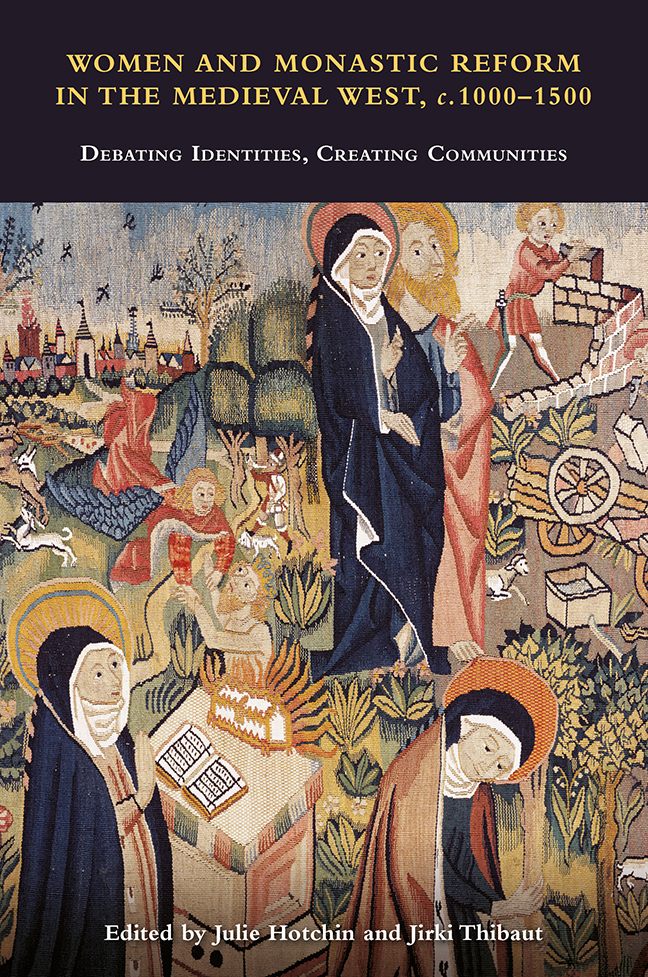 Women and Monastic Reform in the Medieval West, c.100-1500
Women and Monastic Reform in the Medieval West, c.100-1500 Book contents
- Frontmatter
- Dedication
- Contents
- List of Illustrations
- List of Contributors
- Acknowledgements
- List of Abbreviations
- 1 Debating Identities: Women and Monastic Reform in the Medieval West, c. 1000–1500
- 2 Liturgy and Female Monastic Hagiography Around the Year 1000: A lecture croisée of the Life of Liutrud, the Second Life of Glodesind of Metz and the So-called Pontificale Romano-Germanicum
- 3 Remakers of Reform: The Women Religious of Leominster and their Prayerbook
- 4 The Materiality of Female Religious Reform in Twelfth-Century Ireland: The Case of Co-located Religious Houses
- 5 Women as Witnesses: Picturing Gender and Spiritual Identity in a Twelfth-Century Embroidered Fragment from Northern Germany
- 6 Mulieres religiose and Cistercian Nuns in Northern Italy in the Thirteenth Century: A Choice of ‘Order’
- 7 Circulation of Books and Reform Ideas between Female Monasteries in Medieval Castile: From Twelfth-Century Cistercians to the Observant Reform
- 8 Women, Men and Local Monasticism in Late Medieval Bologna
- 9 Building Community: Material Concerns in the Fifteenth-Century Monastic Reform
- 10 Who Made Reform Visible? Male and Female Agency in Changing Visual Culture
- 11 Nuns, Cistercian Chant and Observant Reform in the Southern Low Countries
- Index
- Other volumes in Studies in the History of Medieval Religion
10 - Who Made Reform Visible? Male and Female Agency in Changing Visual Culture
Published online by Cambridge University Press: 09 January 2024
- Frontmatter
- Dedication
- Contents
- List of Illustrations
- List of Contributors
- Acknowledgements
- List of Abbreviations
- 1 Debating Identities: Women and Monastic Reform in the Medieval West, c. 1000–1500
- 2 Liturgy and Female Monastic Hagiography Around the Year 1000: A lecture croisée of the Life of Liutrud, the Second Life of Glodesind of Metz and the So-called Pontificale Romano-Germanicum
- 3 Remakers of Reform: The Women Religious of Leominster and their Prayerbook
- 4 The Materiality of Female Religious Reform in Twelfth-Century Ireland: The Case of Co-located Religious Houses
- 5 Women as Witnesses: Picturing Gender and Spiritual Identity in a Twelfth-Century Embroidered Fragment from Northern Germany
- 6 Mulieres religiose and Cistercian Nuns in Northern Italy in the Thirteenth Century: A Choice of ‘Order’
- 7 Circulation of Books and Reform Ideas between Female Monasteries in Medieval Castile: From Twelfth-Century Cistercians to the Observant Reform
- 8 Women, Men and Local Monasticism in Late Medieval Bologna
- 9 Building Community: Material Concerns in the Fifteenth-Century Monastic Reform
- 10 Who Made Reform Visible? Male and Female Agency in Changing Visual Culture
- 11 Nuns, Cistercian Chant and Observant Reform in the Southern Low Countries
- Index
- Other volumes in Studies in the History of Medieval Religion
Summary
In recent years, many scholars have examined the impact of monastic reform on the visual culture of women's religious communities, in particular for fifteenthand early sixteenth-century Germany. It is common sense that nuns’ production of tapestries, illuminated manuscripts and other works of art that formed part of a convent's visual culture served reform ideals, as the monastic rules prescribe manual labour. The topics depicted on such objects served to internalise spiritual ideas that were characteristic of certain branches of reform such as the Dominican Observance or the Augustinian Congregation of Windesheim. Therefore, adjusting or reviving visual culture was one of the distinctive features of reform in late medieval women's convents, alongside the production of new books and a renewal of liturgy. Scholars have argued that male reformers and provosts had a strong influence on the production of images within the female communities under their supervision. Other historians and art historians have observed that nuns and canonesses also had opportunities to shape the material and visual culture of reform. Nevertheless, the question to what extent male clerics or the women they took care of influenced artistic production in the service of reform remains contested. In this chapter I would like to examine this question in a systematic manner, drawing upon written sources and the visual evidence from fifteenth-century Germany. On what basis is it possible to distinguish between female and male agency when it comes to changing a female convent's visual culture during reform?
Some preliminary remarks concerning the general logic of reform and the ways researchers have dealt with it are necessary to understand how best to approach the problem addressed here. First, we have to distinguish two different methods of reform that scholars have deduced from written sources: reform could be implemented at the behest of the order, for example the Dominican order, or of a bishop, that is via an act of domination; or it could be implemented at the behest of the inhabitants of a women's community, indicating a more voluntary and active act. In the case that reform was imposed upon a convent, any change in a convent's visual culture was also likely to be imposed; when reform came from within the community, changes in visual culture were more likely to be voluntary.
- Type
- Chapter
- Information
- Women and Monastic Reform in the Medieval West, c.100-1500Debating Identities, Creating Communities, pp. 227 - 248Publisher: Boydell & BrewerPrint publication year: 2023


